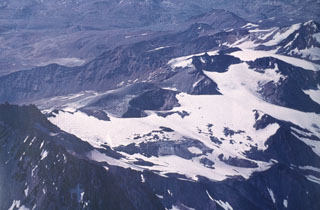Report on Planchon-Peteroa (Chile) — 6 October-12 October 2010
Smithsonian Institution / US Geological Survey
Weekly Volcanic Activity Report, 6 October-12 October 2010
Managing Editor: Sally Sennert.
Please cite this report as:
Global Volcanism Program, 2010. Report on Planchon-Peteroa (Chile) (Sennert, S, ed.). Weekly Volcanic Activity Report, 6 October-12 October 2010. Smithsonian Institution and US Geological Survey.
Planchon-Peteroa
Chile
35.223°S, 70.568°W; summit elev. 3977 m
All times are local (unless otherwise noted)
SERNAGEOMIN reported that during an overflight of Planchón-Peteroa on 30 September scientists observed an ash plume that rose 400 m and drifted E, diffusing over a wide area of Argentina. Parts of the ash plume drifted E and then NE, traveling tens of kilometers with an altitude as high as 6 km (19,700 ft) a.s.l. Also, a diffuse plume drifted S and SE at an altitude of 3 km (10,000 ft) a.s.l. On 1 October an ash plume drifted N and NW as far as Los Queñes, 30 km NW. A sulfur odor was also reported in Los Queñes. Based on analyses of satellite imagery, pilot observations, and SIGMET notices, the Buenos Aires VAAC reported that during 6-12 October ash plumes from Planchón-Peteroa rose to altitudes of 3-6.1 km (10,000-20,000 ft) a.s.l. and drifted in multiple directions. The Alert Level remained at 4, Yellow.
Geological Summary. Planchón-Peteroa is an elongated complex volcano along the Chile-Argentina border with several overlapping calderas. Activity began in the Pleistocene with construction of the basaltic-andesite to dacitic Volcán Azufre, followed by formation of basaltic and basaltic-andesite Volcán Planchón, 6 km to the north. About 11,500 years ago, much of Azufre and part of Planchón collapsed, forming the massive Río Teno debris avalanche, which traveled 95 km to reach Chile's Central Valley. Subsequently, Volcán Planchón II was formed. The youngest volcano, andesitic and basaltic-andesite Volcán Peteroa, consists of scattered vents between Azufre and Planchón. Peteroa has been active into historical time and contains a small steaming crater lake. Historical eruptions from the complex have been dominantly explosive, although lava flows were erupted in 1837 and 1937.
Sources: Servicio Nacional de Geología y Minería (SERNAGEOMIN), Buenos Aires Volcanic Ash Advisory Center (VAAC)

